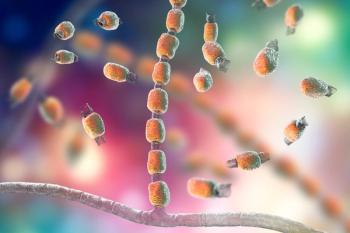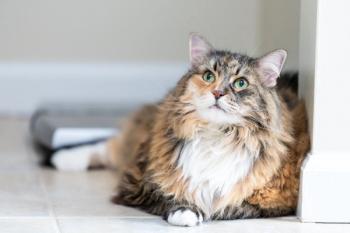
Image Quiz: A dental radiography curiosity in a corgi
Correct answer: Image Quiz: A dental radiography curiosity in a corgi
A patent nasopalatine duct is correct!
The finding of a patent nasopalatine duct often is incidental and associated with no clinical signs in dogs and cats. No treatment is indicated. A patent nasopalatine duct is common in mammals such as pigs, monkeys, cats, dogs, and rabbits but is rare in people.1 Synonyms for this normal finding include incisive duct, Stensen's canal, and incisive canal.
Anatomy
The oral orifice of the nasopalatine duct lies lateral to either side of the incisive papilla.2 The duct leaves the oral cavity by slitlike openings; it extends caudodorsally for 1 to 2 cm though the palatine fissure and opens onto the floor of the nasal fossa.2
Although anatomical studies regarding variation in people exist, to our knowledge these studies do not exist in veterinary medicine. The nasopalatine duct can be conical or cylindrical. It can exit centrally, unilaterally, or bilaterally in the area of the incisive papilla near the midline of the hard palate. One to four of these foramina can be found in the nasopalatine duct, and up to six openings have been noted in the literature. When more than one foramina is present, the nasopalatine duct is considered a variant of a Y-shaped canal.1,3
Function
The nasopalatine duct communicates directly with the cavity of the vomeronasal organ before opening into the nasal fossa.2 The vomeronasal organ of mammals senses liquid and gas chemicals called pheromones that are pumped in and out of the organ through the nasopalatine duct. These pheromones act as stimuli for the vomeronasal organ, sending social and sexual signals to the animal.
It has been proposed that the nasopalatine duct remains patent in certain mammals to allow for the passage of pheromone stimuli into the vomeronasal organ.4,5 The need for acute sense of taste and smell have decreased over time in people, which has obviated the need for a patent nasopalatine duct.1,6
Radiographic appearance
The nasopalatine duct is difficult to visualize radiographically because the rostral maxilla shows superimposition of the incisive foramen over the apex of one or both central incisors, which has led to inaccurate endodontic diagnosis and improper treatment in people.1,7 The intraoral radiographic image of the duct is generally projected between the roots of the central incisors; however, this patient lacks the first and second incisors and, thus, does not have central incisor roots. Additionally, the incisive foramen varies widely in shape, size, and sharpness. Despite the lack of central incisors, the nasopalatine duct is difficult to visualize in this patient because of decreased opacity in the area where the incisor roots were removed.
With the placement of a small file, a radiopaque line can be seen extending from the nasopalatine duct opening into the nasal cavity. This is the best method for visualizing a patent nasopalatine duct radiographically, and the insertion of a small file or gutta-percha point (also called gutta-percha cone) also helps to produce an image of higher diagnostic quality during computed tomography scanning. A gutta-percha point has been used during a computed tomography scan to visualize the entire route of the duct from oral cavity to nasal floor.8
Nasopalatine ducts in people
Although patent nasopalatine ducts and associated pathologies have been reported rarely in the veterinary literature, pathologic differentials in people include draining nasopalatine duct cysts, odontogenic fibromas, oronasal fistulas, and chronic draining dentoalveolar abscesses with sinus tracts.1 In people, aspiration of food and liquid into the nose via the duct can be a source of chronic nasal discharge.1 Clinical signs of a patent nasopalatine duct in people include trapped debris, a whistling sound, small visible pits lateral in the incisive papilla, and occasional discharge, swelling, or pain.9
What you need to know
Although maxillofacial reconstruction and extensive endodontic surgery are not as common in veterinary medicine as in people, veterinarians and veterinary technicians need to be aware of the presence of the nasopalatine duct and that variations in the morphology of the nasopalatine duct could exist. This can affect anesthetic administration and surgery of the rostral maxilla, particularly when using dental implants and performing palate surgeries. Veterinarians and veterinary technicians are reminded of this rarely noticed anatomic finding during dental prophylaxis and are reminded to avoid unnecessary testing or treatment.
REFERENCES
1. Moss HD, Hellstein JW, Johnson JD. Endodontic considerations of the nasopalatine duct region. J Endodont 2000;26(2):107-110.
2. Evans HE. The digestive apparatus and abdomen. In: Evans H, ed. Miller's anatomy of the dog. 3rd ed. Philadelphia, Pa: WB Saunders Co, 1993;386.
3. Bornstein MM, Balsiger R, Sendi P, et al. Morphology of the nasopalatine canal and dental implant surgery: a radiographic analysis of 100 consecutive patients using limited cone-beam computed tomography. Clin Oral Implants Res 2011;22(3):295-301.
4. Shimp KL, Bhatnagar KP, Bonar CJ, et al. Ontogeny of the nasopalatine duct in primates. Anat Rec A Discov Mol Cell Evol Biol 2003;274(1):862-869.
5. Salazar I, Sanchez Quinteiro PS, Cifuentes JM. Comparative anatomy of the vomeronasal cartilage in mammals: mink, cat, dog, pig, cow, and horse. Ann Anat 1995;177(5):475-481.
6. Abrams AM, Howell FV, Bullock WK. Nasopalatine cysts. Oral Surg Oral Med Oral Pathol 1963;16:306-332.
7. Chandler NP, Gray A. Patent nasopalatine ducts: a case report. N Z Dent J 1996;92(409):80-82.
8. Catros S, De Gabory L, Stoll D, et al. Use of gutta percha cones in CT scan imaging for patent nasopalatine duct. Int J Oral Maxillofac Surg 2008;37(11):1065-1066.
9. Chapple IL, Ord RA. Patent nasopalatine ducts: four case presentations and review of the literature. Oral Surg Oral Med Oral Pathol 1990;69(5):554-558.
Newsletter
From exam room tips to practice management insights, get trusted veterinary news delivered straight to your inbox—subscribe to dvm360.




